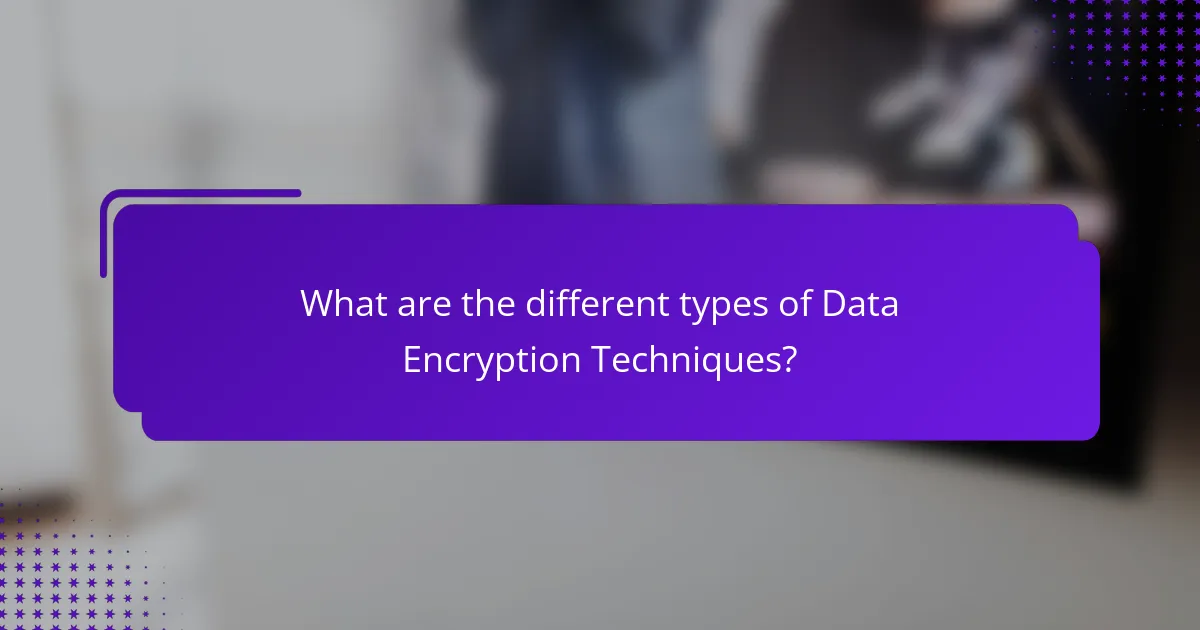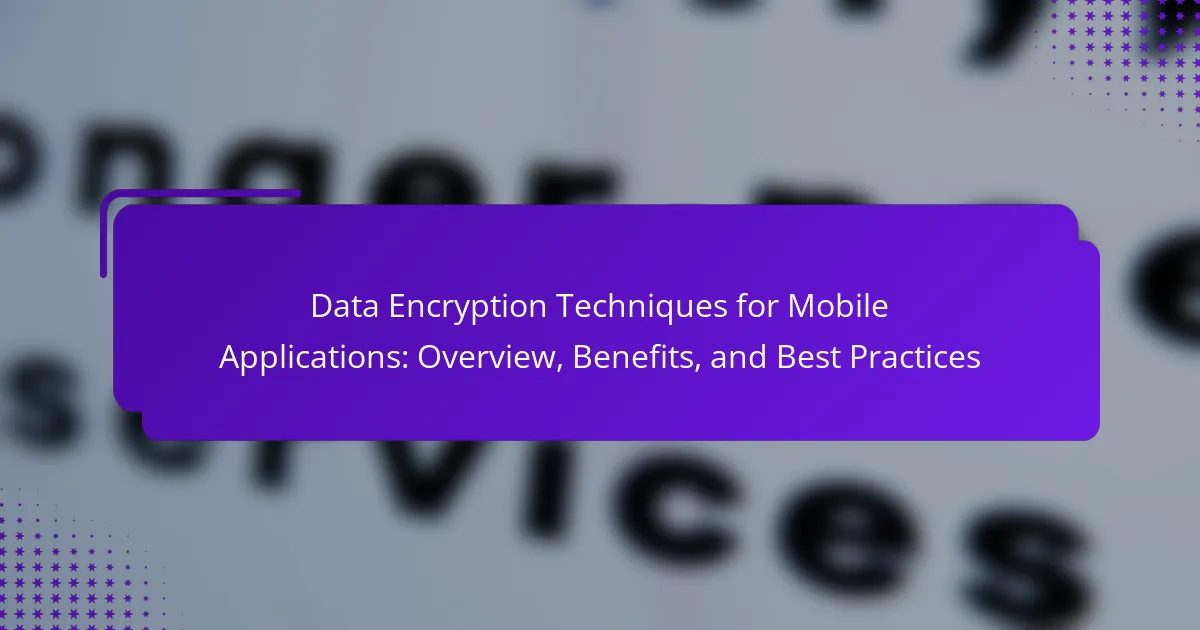Data encryption techniques are essential for securing sensitive information in mobile applications. This article provides an overview of three primary encryption methods: symmetric encryption, which uses a single key for both encryption and decryption; asymmetric encryption, which utilizes a pair of keys for secure communication; and hashing, which converts data into a fixed-size irreversible string. Key algorithms such as AES, RSA, SHA-256, and MD5 are discussed, highlighting their roles in protecting data from unauthorized access and ensuring data integrity. Additionally, the article emphasizes the importance of encryption in mitigating cyber threats and complying with regulatory standards like GDPR and HIPAA.

What are Data Encryption Techniques for Mobile Applications?
Data encryption techniques for mobile applications include symmetric encryption, asymmetric encryption, and hashing. Symmetric encryption uses a single key for both encryption and decryption. Examples include AES (Advanced Encryption Standard) and DES (Data Encryption Standard). Asymmetric encryption employs a pair of keys: a public key for encryption and a private key for decryption. RSA (Rivest-Shamir-Adleman) is a widely used asymmetric encryption algorithm. Hashing transforms data into a fixed-size string, making it irreversible. Common hashing algorithms are SHA-256 and MD5. These techniques protect sensitive data from unauthorized access and ensure data integrity in mobile applications.
How do these techniques enhance mobile application security?
Data encryption techniques enhance mobile application security by protecting sensitive information from unauthorized access. These techniques encrypt data, making it unreadable to anyone without the decryption key. For instance, AES (Advanced Encryption Standard) is widely used for its robust security and efficiency. By encrypting data at rest and in transit, mobile applications can safeguard user information from potential breaches. Additionally, encryption helps maintain user privacy and compliance with regulations like GDPR. Implementing strong encryption protocols reduces the risk of data theft and enhances overall trust in mobile applications.
What types of data are commonly encrypted in mobile applications?
Common types of data encrypted in mobile applications include personal identification information, financial data, and health records. Personal identification information often consists of names, addresses, and social security numbers. Financial data typically includes credit card numbers and banking information. Health records may encompass medical histories and treatment details. These data types are encrypted to protect user privacy and comply with regulations. For instance, the Health Insurance Portability and Accountability Act (HIPAA) mandates the encryption of health data. Encryption secures data during transmission and storage, reducing the risk of unauthorized access.
What are the common threats that encryption helps mitigate?
Encryption helps mitigate common threats such as data breaches, unauthorized access, and eavesdropping. Data breaches occur when sensitive information is exposed to unauthorized individuals. Unauthorized access refers to individuals gaining entry to systems or data without permission. Eavesdropping involves intercepting communications to capture sensitive information. Encryption secures data by converting it into a format that is unreadable without the correct decryption key. This makes it significantly harder for attackers to exploit the data. According to the Verizon Data Breach Investigations Report, 81% of data breaches involve stolen or weak passwords. Encryption helps protect against these vulnerabilities by ensuring that even if data is intercepted, it remains secure.
Why is data encryption essential for mobile applications?
Data encryption is essential for mobile applications to protect sensitive user data. Mobile devices are often targets for cyberattacks, making encryption crucial for safeguarding personal information. Encryption converts data into a secure format that unauthorized users cannot access. This ensures that even if data is intercepted, it remains unreadable without the proper decryption key. According to a report by Verizon, 43% of data breaches involve small businesses, highlighting the need for robust security measures. Additionally, encryption helps comply with data protection regulations, such as GDPR and HIPAA, which mandate the protection of personal data. Overall, data encryption enhances user trust and secures mobile applications against potential threats.
How does encryption protect user privacy?
Encryption protects user privacy by converting data into a coded format. This process ensures that only authorized parties can access the original information. When data is encrypted, it becomes unreadable to anyone without the correct decryption key. This secures sensitive information such as personal messages, financial details, and login credentials.
According to a study by the National Institute of Standards and Technology (NIST), encryption significantly reduces the risk of data breaches. The study highlights that encrypted data is less likely to be exploited by cybercriminals. Additionally, encryption helps comply with privacy regulations like GDPR and HIPAA. These regulations mandate the protection of personal data, and encryption is a key method to achieve compliance.
What regulatory requirements influence the need for encryption?
Regulatory requirements influencing the need for encryption include laws such as GDPR and HIPAA. The General Data Protection Regulation (GDPR) mandates data protection measures for personal data. It requires organizations to implement appropriate technical measures, including encryption, to safeguard data. Non-compliance can result in significant fines, underscoring the importance of encryption. The Health Insurance Portability and Accountability Act (HIPAA) also requires encryption for electronic protected health information (ePHI). Organizations must ensure that ePHI is secure to comply with HIPAA standards. Failure to encrypt can lead to data breaches and legal repercussions. Thus, regulatory frameworks strongly advocate for encryption as a critical security measure.

What are the different types of Data Encryption Techniques?
The different types of data encryption techniques include symmetric encryption, asymmetric encryption, and hashing. Symmetric encryption uses a single key for both encryption and decryption. Common algorithms include AES and DES. Asymmetric encryption employs a pair of keys: a public key for encryption and a private key for decryption. RSA and ECC are popular asymmetric algorithms. Hashing transforms data into a fixed-size string of characters, which is typically irreversible. Common hashing algorithms include SHA-256 and MD5. Each technique serves distinct purposes in securing data.
How does symmetric encryption work in mobile applications?
Symmetric encryption in mobile applications uses a single key for both encryption and decryption. This means that the same key is shared between the sender and the receiver. When data is sent, it is transformed into an unreadable format using this key. The intended recipient then uses the same key to convert the data back into its original form.
This method is efficient due to its speed and lower computational requirements. Common algorithms include AES (Advanced Encryption Standard), which is widely adopted for its security and performance. In mobile applications, symmetric encryption protects sensitive data such as personal information and financial details during transmission.
The effectiveness of symmetric encryption relies on the secrecy of the key. If the key is compromised, the security of the encrypted data is also at risk. Therefore, secure key management practices are essential in mobile applications to maintain the integrity of the encryption process.
What are the advantages and disadvantages of symmetric encryption?
Symmetric encryption has several advantages and disadvantages. One advantage is speed; symmetric encryption algorithms are generally faster than asymmetric ones. This efficiency makes them ideal for encrypting large amounts of data quickly. Another advantage is the simplicity of key management; only one key is needed for both encryption and decryption.
However, symmetric encryption also has disadvantages. A major drawback is the risk of key distribution; if the key is intercepted during transmission, the data can be compromised. Additionally, symmetric encryption does not provide authentication, making it harder to verify the identity of the communicating parties. Lastly, if the key is lost, the encrypted data becomes inaccessible, posing a significant risk for data recovery.
What is asymmetric encryption and how is it applied?
Asymmetric encryption is a cryptographic technique that uses a pair of keys for secure data transmission. One key is public and can be shared openly. The other key is private and must be kept secret. Data encrypted with the public key can only be decrypted by the corresponding private key. This method ensures that only the intended recipient can access the original data.
Asymmetric encryption is commonly applied in various security protocols. It is used in SSL/TLS for secure web communications. It also underpins email encryption standards like PGP. Additionally, it is employed in digital signatures to verify the authenticity of messages. The use of asymmetric encryption enhances the security of mobile applications by protecting sensitive user information during transmission.
How does the key exchange process work in asymmetric encryption?
In asymmetric encryption, the key exchange process involves the use of a pair of keys: a public key and a private key. The sender uses the recipient’s public key to encrypt a message. This ensures that only the recipient can decrypt the message using their private key.
When the recipient receives the encrypted message, they apply their private key to decrypt it. This method guarantees secure communication, as the private key is never shared. As a result, even if an attacker intercepts the encrypted message, they cannot decrypt it without access to the private key.
The security of this process relies on mathematical algorithms, such as RSA or ECC, which make it computationally infeasible to derive the private key from the public key. This principle is fundamental to the security of asymmetric encryption systems.

What are the benefits of implementing Data Encryption Techniques?
Data encryption techniques provide enhanced security for sensitive information. They protect data from unauthorized access during storage and transmission. Encryption ensures that only authorized users can access the data. This reduces the risk of data breaches and identity theft. Implementing encryption can also help organizations comply with regulatory requirements, such as GDPR and HIPAA. According to a report by Cybersecurity Ventures, cybercrime damages are projected to reach $10.5 trillion annually by 2025. Therefore, encryption serves as a critical defense mechanism against increasing cyber threats.
How does encryption improve user trust in mobile applications?
Encryption enhances user trust in mobile applications by safeguarding sensitive data. It ensures that personal information remains confidential and protected from unauthorized access. When users know their data is encrypted, they feel more secure using the app. This security is crucial, especially in applications handling financial transactions or personal health information. Studies show that 80% of users are more likely to trust apps that utilize encryption. Additionally, encryption helps prevent data breaches, which can damage user confidence. By employing strong encryption methods, developers signal their commitment to user privacy and security. This commitment fosters a positive relationship between users and the application.
What role does encryption play in data integrity?
Encryption ensures data integrity by protecting data from unauthorized modifications. It uses algorithms to encode information, making it unreadable without the correct decryption key. This process prevents attackers from altering data during transmission or storage. For instance, when data is encrypted, any unauthorized changes will render the data invalid upon decryption. This capability is crucial in maintaining trust in data exchanges, especially in mobile applications. According to a study by the National Institute of Standards and Technology, encryption significantly reduces the risk of data tampering. Therefore, encryption is essential for verifying that data remains unchanged and reliable throughout its lifecycle.
What best practices should developers follow when implementing encryption?
Developers should follow several best practices when implementing encryption. First, they must use strong encryption algorithms, such as AES with a key size of at least 256 bits. This ensures high security against brute-force attacks. Second, developers should manage encryption keys securely. They should use hardware security modules (HSMs) or secure key management services to prevent unauthorized access.
Third, developers need to implement encryption at rest and in transit. This protects data stored on devices and data being transmitted over networks. Fourth, they should regularly update and patch encryption libraries. Vulnerabilities in cryptographic libraries can lead to security breaches.
Fifth, developers should conduct thorough security audits and testing. This helps identify potential weaknesses in the encryption implementation. Lastly, they must educate users about the importance of strong passwords and authentication methods. This enhances overall security in conjunction with encryption.
How can developers ensure strong encryption key management?
Developers can ensure strong encryption key management by implementing a combination of best practices. First, they should use a secure key generation process. This involves utilizing cryptographic libraries that comply with industry standards. Next, developers must store keys securely, using hardware security modules or secure enclaves. Access to keys should be restricted to authorized personnel only. Regularly rotating keys can mitigate the risk of compromise. Developers should also utilize key lifecycle management practices. This includes securely archiving or destroying keys that are no longer in use. Monitoring access and usage of keys can help detect unauthorized attempts. Following these practices can significantly enhance encryption key management.
What tools and libraries are recommended for mobile encryption?
Recommended tools and libraries for mobile encryption include OpenSSL, Bouncy Castle, and Libsodium. OpenSSL provides a robust set of cryptographic functions. It is widely used for secure communications. Bouncy Castle offers lightweight cryptography for Java and Android. It supports various encryption algorithms and protocols. Libsodium is known for its simplicity and security. It is suitable for both iOS and Android platforms. These libraries are frequently updated and widely trusted in the developer community. They help ensure data protection in mobile applications.
What common pitfalls should be avoided in mobile application encryption?
Common pitfalls in mobile application encryption include using outdated algorithms. This can lead to vulnerabilities that hackers can exploit. Another pitfall is hardcoding encryption keys within the app. This practice makes it easier for attackers to access sensitive data. Additionally, neglecting to encrypt data at rest is a significant oversight. Data stored on devices can be compromised if not properly secured. Failing to implement proper key management can also create security gaps. Poor key management increases the risk of unauthorized access. Lastly, not regularly updating encryption protocols can leave applications exposed to new threats. Keeping encryption methods current is essential for maintaining security.
Data encryption techniques for mobile applications are essential for protecting sensitive information from unauthorized access. This article provides an overview of various encryption methods, including symmetric encryption, asymmetric encryption, and hashing, detailing their functions and applications in mobile security. It also discusses the types of data commonly encrypted, the threats that encryption mitigates, and the regulatory requirements that necessitate encryption practices. Furthermore, the article highlights the benefits of encryption in enhancing user trust and data integrity, while outlining best practices for developers to implement robust encryption strategies effectively.
